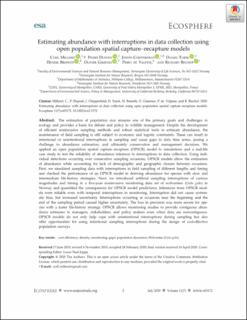| dc.contributor.author | Milleret, Cyril Pierre | |
| dc.contributor.author | Dupont, Pierre | |
| dc.contributor.author | Chipperfield, Joseph | |
| dc.contributor.author | Turek, Daniel | |
| dc.contributor.author | Brøseth, Henrik | |
| dc.contributor.author | Gimenez, Olivier | |
| dc.contributor.author | de Valpine, Perry | |
| dc.contributor.author | Bischof, Richard | |
| dc.date.accessioned | 2020-11-25T15:42:40Z | |
| dc.date.available | 2020-11-25T15:42:40Z | |
| dc.date.created | 2020-08-27T13:29:36Z | |
| dc.date.issued | 2020 | |
| dc.identifier.citation | Ecosphere. 2020, 11(7), e03172 | en_US |
| dc.identifier.issn | 2150-8925 | |
| dc.identifier.uri | https://hdl.handle.net/11250/2689638 | |
| dc.description.abstract | The estimation of population size remains one of the primary goals and challenges in ecology and provides a basis for debate and policy in wildlife management. Despite the development of efficient noninvasive sampling methods and robust statistical tools to estimate abundance, the maintenance of field sampling is still subject to economic and logistic constraints. These can result in intentional or unintentional interruptions in sampling and cause gaps in data time series, posing a challenge to abundance estimation, and ultimately conservation and management decisions. We applied an open population spatial capture–recapture (OPSCR) model to simulations and a real‐life case study to test the reliability of abundance inference to interruptions in data collection. Using individual detections occurring over consecutive sampling occasions, OPSCR models allow the estimation of abundance while accounting for lack of demographic and geographic closure between occasions. First, we simulated sampling data with interruptions in field sampling of different lengths and timing and checked the performance of an OPSCR model in deriving abundance for species with slow and intermediate life‐history strategies. Next, we introduced artificial sampling interruptions of various magnitudes and timing to a five‐year noninvasive monitoring data set of wolverines (Gulo gulo) in Norway and quantified the consequences for OPSCR model predictions. Inferences from OPSCR models were reliable even with temporal interruptions in monitoring. Interruption did not cause systematic bias, but increased uncertainty. Interruptions occurring at occasions near the beginning and the end of the sampling period caused higher uncertainty. The loss in precision was more severe for species with a faster life‐history strategy. OPSCR allows monitoring studies to provide contiguous abundance estimates to managers, stakeholders, and policy makers even when data are noncontiguous. OPSCR models do not only help cope with unintentional interruptions during sampling but also offer opportunities for using intentional sampling interruptions during the design of cost‐effective population surveys. cost efficiency; density; monitoring; gaps; population dynamics; Wolverine (Gulo gulo) | en_US |
| dc.language.iso | eng | en_US |
| dc.rights | Attribution-NonCommercial-NoDerivatives 4.0 Internasjonal | * |
| dc.rights.uri | http://creativecommons.org/licenses/by-nc-nd/4.0/deed.no | * |
| dc.title | Estimating abundance with interruptions in data collection using open population spatial capture–recapture models | en_US |
| dc.type | Peer reviewed | en_US |
| dc.type | Journal article | en_US |
| dc.description.version | publishedVersion | en_US |
| dc.source.pagenumber | 14 | en_US |
| dc.source.volume | 11 | en_US |
| dc.source.journal | Ecosphere | en_US |
| dc.source.issue | 7 | en_US |
| dc.identifier.doi | 10.1002/ecs2.3172 | |
| dc.identifier.cristin | 1825539 | |
| dc.relation.project | Andre: Norwegian Environment Agency | en_US |
| dc.relation.project | Andre: Swedish Environmental Protection Agency | en_US |
| dc.relation.project | Norges forskningsråd: 286886 | en_US |
| dc.source.articlenumber | e03172 | en_US |
| cristin.ispublished | true | |
| cristin.fulltext | original | |
| cristin.qualitycode | 1 | |

